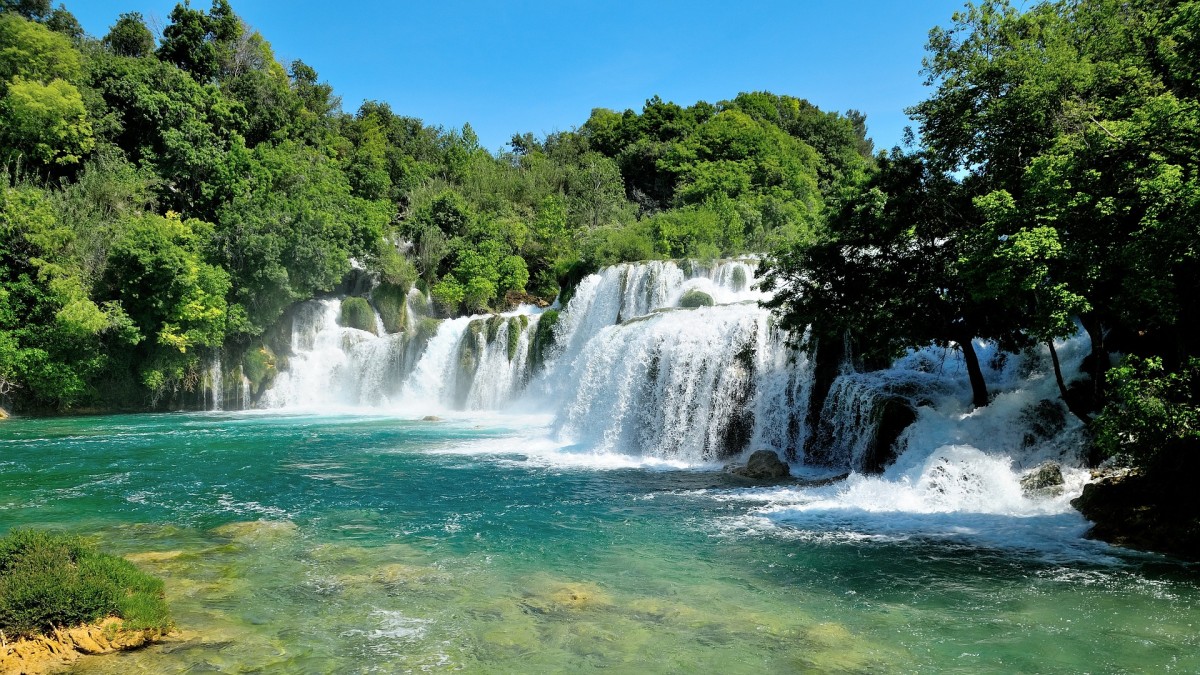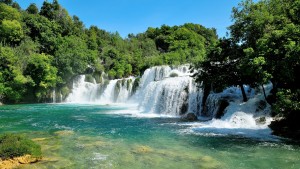Located near the village Skradin near the coastal town Šibenik in Dalmatia and it is easy reachable by car, there are also bus excursions from Šibenik which can be booked there. A splendid National park with waterfalls and several beautiful walking trails with wooden footbridges through the woods and along and over the Krka river. A part of the rivers is accessible for swimming and sunbathing, and during the summer months there are boat excursions.
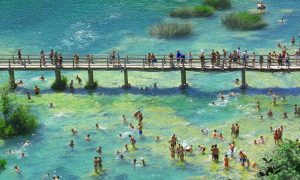
photo ©Pixabay_Superfactice
The main road entrance into the park is the ‘Lozovac’ entrance. From the free parking area, after you bought your entrance ticket you are transported by bus -March – October- the rest of the year you can go by car into the park. Skradinski Buk is the longest and most visited series of waterfalls along the Krka river, the waterfalls consist of travertine barriers, islands and lakes which you can see and walk by on the wooden walkways and bridges.
There is an ethno-presentation in the 19th century water mills, with presentations about milling of grain, washing of cloths, weaving of bags and rugs, ploughing, preparation of food in an old-fashioned kitchen and more.
Along the educational trail, takes about one hour, you are offered information about the local flora and fauna, the travertine and aquatic habitats.
From Skradinski Buk there are three different boat excursions that take between 2 to 3.5 hours and visit the Franciscan monastery on the island Visovac, the Roski waterfall, or the Krka Monastery and the ruins of the fortresses of Trosenj and Necven.
The island of Visovac is the site of the Franciscan Monastery of Our Lady of Mercy since 1445, the monastery has an archaeological collection, a collection of ecclesiastical vestments and vessels, and a library.
Where to buy tickets?
At the entrance ‘Lozovac’, entrance Skradin, entrance Roški slap-Laškovica, and entrance Burnum-Puljani.
Where to eat?
In the park are some simple restaurants and some bars selling mostly sandwiches and fast food, while outside the park in the surrounding villages there are various hotels and restaurants where you can eat.
Where to sleep?
The coastal town of Sibenik is only 20 minutes away from the park, there are many accommodation options in the immediate surroundings options are limited.
What to buy?
Local produce is offered by residents, such as dried figs, honey and olive oil. In addition, the park has souvenirs with the NP Krka logo.
When to visit?
The park is open all year long, many amenities are only open from spring to autumn. In late spring, the waterfalls are at its most beautiful because of the higher water levels.
Tips
- Dogs are allowed in NP Krka, except on the island of Visovac, and in the park and during bus and boat trips they must wear a muzzle
- When visiting the monastery on the island of Visovac you should be suitably dressed (covered shoulders, no swimwear or too short skirts and trousers)
- With the access ticket you can also visit the next day via another entrance to visit other parts of the park
- Note that there is also an island just below Pula called ‘Krk’, this is confusing, especially due to the verbs in Croatian, and can be written as ‘Krka’!
Contact
telephone +385 22 201 777
e-mail info@npk.hr
website www.npkrka.hr and www.parkovihrvatske.hr
Apps for mobile phone
NP Krka has made a free, easy to use, AR (augmented reality) mobile application available in 12 languages (English, German, French, Italian, Spanish, Croatian, Slovenian, Russian, Polish, Hungarian, Slovakian and Czech). It shows the entrances and exits, information centra, bus stations, tour boats, restaurants, souvenir shops, ethnological presentations and much more.
You can download the application via Apple and Google application shops:
iOS (iTunes) https://itunes.apple.com/gb/app/krka-national-park-tour/id1093046585?mt=8
Android (Google Play) https://play.google.com/store/apps/details?id=de.menschortweb.krka
National Park Krka
The national park is located near the village of Skradin, about 20 km from the coastal town of Šibenik in Dalmatia and easily accessible by car, but there are also bus and boat excursions to NP Krka from Šibenik. A magnificent national park with waterfalls and some beautiful hiking trails with wooden walkways through the woods and along the river Krka. During the summer months it is allowed to swim and sunbathe at the ‘Skradinski buk’ and ‘Roški waterfall’. During the summer months there are boat trips along the river of NP Krka.
The Krka River and the 7 waterfalls
The source of the beautiful karst river Krka is located near the place Knin, under the Topoljski waterfall, and the river flows into the Adriatic Sea after 72.5 km at the coastal town of Sibenik. The Krka is fed by five tributaries: Krcic, Kosovcica, Orašnica, Butišnica and the Cikola along with the Vrba River. Due to the ongoing process of depositing natural limestone (travertine) in the Krka river, an invaluable natural karst phenomenon is maintained. Travertine is the name for the calcium carbonate (limestone), which precipitates from the water at the rapids over uneven surfaces, such as immersed logs and rough rocks. The river’s chemical balance is disturbed by the swirling of the river water and CO2 is released. Due to the formation of considerable quantities of travertine, there are terraces in the riverbed which create waterfalls, this processoccurs in the Krka river, but also at the lakes of NP Plitvice. These travertine accumulations are very sensitive to changes in the local environment. Due to the continuous production and degradation of the travertine in the river flow, the waterfalls and the associated biodiversity are remained intact. The Krka river has as many as seven watefalls created by travertine deposits: Bilušica buk, Brljan, Manojlovac slap, Rošnjak, Miljacka slap, Roški slap and Skradinski buk.
Waterfall Skradinski buk
Skradinski buk is the seventh, last and longest travertine barrier on the Krka river and is one of the most beautiful aspects in NP Krka. The waterfall is approximately 13 kilometres downstream of the Roški waterfall and 49 km downstream of the source of the river. The growth of travertine at Skradinski buk was caused by the swirls in the waterflow where the river Krka flows together with the river Cikola, which created the formation of the 17 steps of the waterfall. The cascades have a width of 200 to 400 meters and bridge a height difference of 45.7 meters in total. There is a hiking trail along the waterfall, which is a light walk of about an hour. The path leads through the deep shadow of lush Mediterranean vegetation, along mosses and other plant species unique to the travertine barriers, besides the flora, there are many bird species and other animal species found in this unique aquatic environment. Along the route there are restored mills that have traditionally been powered by flow of the river, these buildings are now used as a souvenir shop, restaurant or exhibition space. On the left bank of the river, the remains of the first hydroelectric power station in Croatia are found, which was started on August 28, 1895, only two days after the implementation of the hydroelectric power station on the Niagara River.
The Roški waterfall
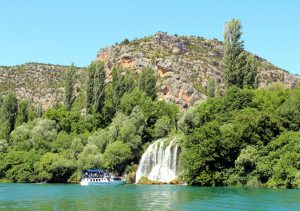
photo ©NP Krka
The sixth waterfall is the Roški slap, the word ‘slap’ means ‘waterfall’ in Croatian. The beginning of the travertine barriers consists of a series of small cascades called “chain” by the locals – while the middle part consists of numerous small lakes and islets. The length of the barrier is almost 650 meters, at the widest it is 450 meters wide, with a total height difference of 22.5 meters. The main waterfall of the cascade is at the end of the barrier where the river Krka fall 15 meters into lake Visovac. Travertine formations at this waterfall are made up of caves, bushes, thresholds and small barriers. Over the waterfall runs a road still dating from Roman times. The Roški slap is interesting because of the characteristic rich vegetation that forms a variation of dry, light, moist and shady habitats. Along the two river banks are old water mills, some of which have been restored and have retained their original function. In addition, there are renovated buildings and appliances used for the production, colouring and washing of fabrics. These are now ethnographic monuments of rural architecture and local trade history.
The Miljacka waterfall
On the left bank of the Krka, just below the waterfall, the Miljacka hydroelectric power station is the largest on the Krka river. The construction began in 1904 and until 1910 it was the most powerful hydroelectric power plant in Europe. One kilometer downstream of Rošnjak, pressed in the riverbed between high cliffs overgrown with lush sub-Mediterranean vegetation, the Miljacka waterfall cascades. It consists of three large and numerous smaller travertine steps in the riverbed with a total height of 23.8 meters. The upper part of the Miljacka waterfall is characterized by small caves, while the lower part has small steps. The Krka is connected via the Miljacka to the Zrmanja River, which constitutes a unique hydro-geological phenomenon. During the dry period the minimum water flow ~ 2 m3/s. About 100 meters downstream of the waterfall, on the right bank of the river is the Miljacka II cave, a habitat for many native and protected underground animals. Among these species, the most special is the ‘olm’, which is with a colony of more than 4000 individuals, one of the largest colonies in Europe. The olm, or caveolm, is a salamander who lives strictly underground throughout his whole life, it is pink-white in colour, has little paws, external gills and can eventually reach a total length of 20-30 cm and lives exclusively in the Karst area of the Dinaric Alps. Unfortunately, access to this waterfall is not possible, and the only access is via the Miljacka hydroelectric power plant, which is closed for unauthorized persons.
The Rošnjak waterfall
Rošnjak is the smallest of all waterfalls along the river Krka, and because of the mystical inaccessibility, the locals call this waterfall ‘the altar’. The cascade is about 40 meters wide and only 8,4 meters high and consists of travertine formations with vegetation and small caves. The waterfall flows in a picturesque gorge sandwiched between nearly 200 meters high cliffs. Due to the inaccessibility, the Rošnjak waterfall is untouched by human hands, but vulnerable to dehydration in the hot summer months, when water is diverted to the Miljacka hydroelectric power station.
The Manojlovac waterfall
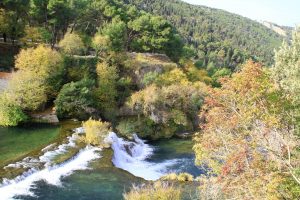
photo ©EMRE d.o.o.
This largest waterfall of the Krka river is located half a mile downstream of Brljan, where the river makes a sharp turn and many visitors call this the most beautiful waterfall and a view of this travertine cascade will remain anchored in your memory as one of the the most impressive natural scenes. The waterfall consists of a series of travertine barriers with a total height of 59.6 meters, with the largest barrier 32.2 meters high. The waterfalls are about 500 meters long, with a width of about 80 meters. The travertine formations of the waterfall are formed by bushes of vegetation and small caves. The area around the waterfall is covered with sub-Mediterranean vegetation, and along the river are some small fields and meadows, with the ruins of abandoned factories at the foot of the waterfall. This waterfall can also dry out at low water levels, as the river water is diverted to the nearby Miljacka hydroelectric power station. In periods of high water, the waterfall falls with a deafening roar, surrounded by a veil of rainbow coloured water drops. The most beautiful view of the waterfall is from the edge of the cliff on the Bukovac side, a few hundred meters from the archaeological site Burnum, on the road Knin-Kistanje. There are no maintained hiking trails along the waterfalls, giving it an extra mystical and innocent beauty.
The Brljan waterfall
A beautiful travertine waterfall which is magnificent to see in spring when it is covered by new green leaves of lush vegetation, later in the season, the lush vegetation limits the view of the waterfall that is drained by low water levels. Located two kilometres downstream of the Bilušica waterfall, at the 400m wide and 1300m long Coric lake (also Brljan lake). The lake was created by the growth of travertine steps in the riverbed and mostly due to the construction of a concrete dam for the Miljacka hydroelectric power station.
Only during high water the river water flows into the lake over the Brljan waterfall, at low water level the river water is sent via a drilled tunnel to the hydroelectric power station. The travertine steps in the riverbed are 300 meters long, 180 meters wide, and bridge a total height difference of 15.5 meters. Above the waterfall there are smaller rivers, rapids and thresholds. There is a path on the Bukovac side of the river, through the gorge and across the waterfall, where visitors can see the remains of the Roman military camp Burnum.
The Bilušica waterfall
This is the first of seven waterfalls along the river Krka, and although damaged, this waterfall is still particularly noisy and attractive because it is not affected by the use of water for a hydroelectric power station. The waterfalls fall in a gorge 16 km downstream of the river source and 9 km downstream of Knin, at an altitude of 214 meters above sea level. The damage to the waterfall has been caused by the use of dynamite in 1834, 1895, 1953 and 1954 to stop flooding that destroyed the Knin agricultural fields. These actions reduced water levels upstream and led to dehydration of the Bobodol lake. Throughout the year, the river Krka flows over this cascade, which consists of two main stages and several intermediate steps of 300 meters overall length. The height difference is 22.4 meters and the waterfall is 100 meters wide. Downstream of the lower waterfall cascade, the riverbed becomes wider and the water flows more calmly. The waterfall is surrounded by lush sub-Mediterranean vegetation and thick purple cat tail. Next to the river, there are several fields where vegetables are grown. Of the numerous mills that were previously in use here, there remain only two mills and a hole used to wash fabrics. The waterfalls can be reached from the Bukovac side via the Knin-Kistanje road by taking the exit to the village Raducic (Omcikus) and then taking the dirt road to the nearby Raducic station.
Flora and fauna
Due to its geographical location and the large number of different habitats, such as travertine barriers, flowing and stagnant water, cliffs, and rocky terrain, the plant life around the Krka River is extremely diverse, with 1022 plant species described so far. The Krka water basin is dominated by hedge beech and scrub, macchia (evergreen dense and thorny shrubs and wild bushes, including wild olives, oleanders, laurel, myrrh, holm, and cork oaks), garrigues (mediterranean vegetation of oak wood, thyme, lavender and juniper berries), grasslands and rocky meadows.
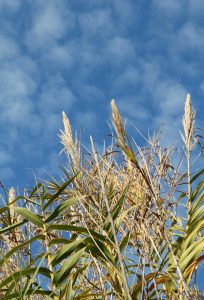
photo ©EMRE d.o.o.
NP Krka’s fauna is very rich and diverse, with many endemic, rare and endangered animal species, which makes the region around the river Krka very valuable to nature, both in Croatia and in Europe. In NP Krka, many underground animals are found, including freshwater cave snails, cave pseudo scorpion, cave isopod, cave polychaet, olm, and cave cricket. There are ten fish species that are endemic to the Adriatic basins, such as the Adriatic salmon, Adriatic dace, Dalmatian minnow, Croatian dace. NP Krka is also the habitat of four species listed on the European list of endangered species: greater horseshoe bat, wolf, otter and wild cat.
Access to the park
Entrance Lozovac
From the highway, access to the entrance of NP Krka is clearly indicated, then you arrive at the Lozovac entrance, where you find a free car park. Here an entrance ticket can be bought and you are transported by bus into the park. This applies for the months of March to October, the rest of the year you can drive into the park by car. Skradinski Buk is the longest and most visited series of waterfalls along the Krka river, the waterfalls consist of travertine barriers, there are islands and lakes that you can admire as you walk through NP Krka over the wooden paths and bridges. Travertine is a white or light coloured limestone derived from mineral deposition, which has traditionally been used in construction.
Entrance Skradin
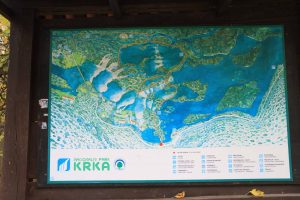
photo ©EMRE d.o.o.
The other less used entrance for NP Krka is the Skradin entrance on the road from Šibenik to Knin in the village of Skradin, where there is a large parking space, and in the summer months it is also busy here. From this entrance there is a 25-minute boat ride to the waterfall ‘Skradinski Buk’ every hour. It is a 5-minute walk to the start of the hiking route. The return trip is again with the same boat departing every hour at half an hour. In January, February and December there are no boats from Skradin and in the months of November, only when weather permits, check for the current shipping schedule on NP Krka’s website.
From the port of Šibenik it is also possible to sail by boat to NP Krka, which takes about 1.5 hours and goes through a canal and Prukljan – Skradin lake. These tours are organized in the summer months, informing on site for the possibilities.
Entrance Roški Waterfall / Laškovica
At the entrance Roški waterfall / Laškovica you can buy entrance tickets and tickets for the boat trip to the monastery, the entrance can be reached via the Drniš, Knin and Skradin road, or by NP Krka’s cruise boats. The natural beauty of the Roški waterfall can be viewed all year long, the presentation is open from April to October, and boat trips from the Roški waterfall to the Krka monastery, and the Trošenj and Nečven forts are available daily from April to June when water levels are high.
Entrance Burnum / Puljani
At the Burnum/Puljani entrance you find the archaeological site Burnum, located above the canyon, waterfalls and lakes of the Krka River in an area of exceptional beauty and natural characteristics. At the location in Ivoševci you can see the remains of the only Roman military amphitheatre in Croatia. The archaeological artefacts excavated here, such as weapons, tools, daily objects, are presented in the centre of the town Puljani. Burnum can only be reached by road. The site and archaeological collection are open to visitors throughout the year. Guided tours with an archaeologist include a visit to the amphitheatre and the military camp. For more information or to make a reservation: contact by e-mail: info@npk.hr or by telephone at +385 22 201 777, +385 22 662 356.
Krka Monastery
The Krka Monastery (Croatian: Manastir Krka) can be visited via an organized 2.5 hour boat trip between Roški Waterfall – Krka Monastery – and the medieval forts Nečven and Trošenj during the period April to October. The Krka Monastery is also accessible by car or by bus from Kistanje all year round. To do this, follow the signs from Kistanje to the Krka Monastery via a downwind road with hairpin bends, below there is a parking space. From the monastery there is a half-hour educational hiking trail through the surrounding nature.
Etno village
In the NP Krka you find an ethno-presentation with a 19th century water mill, presentations about grinding grain, washing fabrics, weaving bags and carpets, farm ploughs, cooking food in an old-fashioned kitchen and much more.
Hiking trails
A 2 km long educational hiking trail runs around the Skradin waterfall, this easy trail over wooden walkways and bridges takes about an hour. There is another 8.5 km long educational trail that runs through Stinice – Roški Slap – Visovac and this is a very nice hiking trail through nature. Along both routes there are information signs that explain the local flora and fauna, the formation of travertine, aquatic habitats and local archaeology.
Boat trips
From Skradinski Buk there are three different boat trips that last from 2 to 3.5 hours, and visit the Franciscan monastery on Visovac Island, the Roski Waterfall, or the Krka Monastery and the ruins of Trošenj and Nečven’s forts. The island of Visovac has since 1445 been the place of the Franciscan monastery of Our Lady of Mercy, the monastery has an archaeological collection, a collection of church robes and chalices and a library.
Guided tours
It is possible to book a guided tour when purchasing your ticket. There are various hiking and boat guided tours to choose from.

